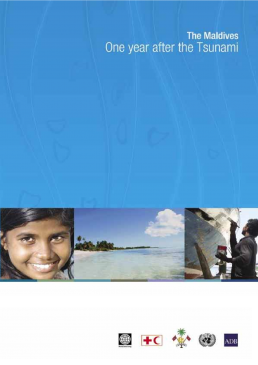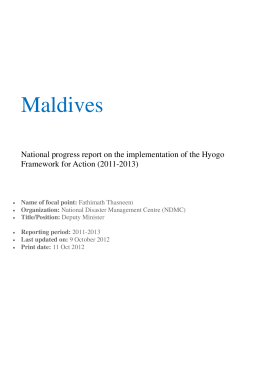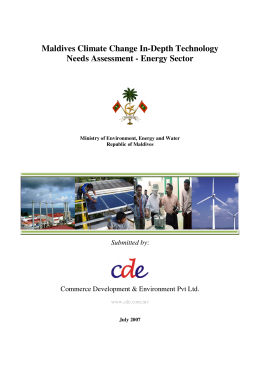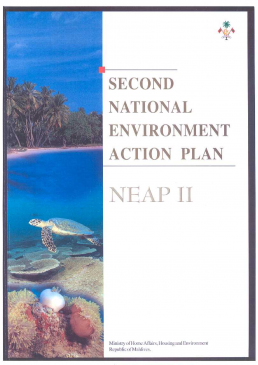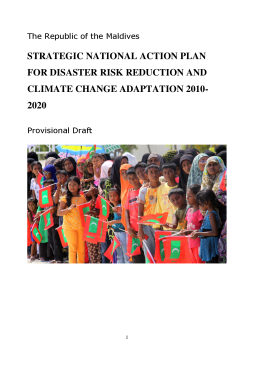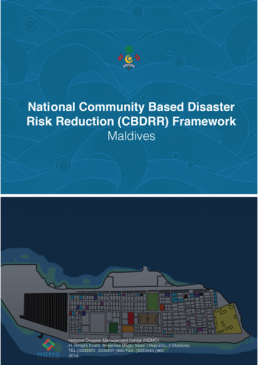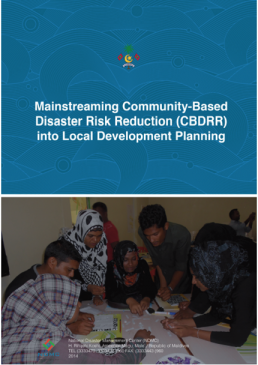Welcome to National Disaster Management Authority, Maldives
Source(s): Government of the Republic of Maldives, Asia Development Bank, International Federation of the Red Cross and Red Crescent Societies, United Nation, World Bank, Government of Japan, American Red Cross, Australian Red Cross, Canadian Red Cross, French Red Cross, OCHA, UNDP, UNEP, UNFPA, UNICEF, WFP and WHO
Author: Ministry of Planning and National Development
Number of pages: 39
The final report represents a shared overview of the main achievements of the year 2005 and the key challenges that lie ahead.
Author: John E. Hay, New Zealand
Number of pages: 23
This climate risk profile (CRP) is based on observed data for Hulhulé (Latitude 4 N; Longitude 73 E. Except for the sea level data, which were sourced from the University of Hawaii web site, all the data used in preparing this climate risk profile were provided by the Department of Meteorology, Government of the Maldives. The cooperation and assistance of Departmental staff is acknowledged with gratitude. While data for Hulhulé cannot characterize the climate conditions for the entire country, they do provide a general indication of current climate risks for the Maldives. But it is highly desirable to repeat the current evaluation of climate-related risks using data for other locations in the Maldives.
Source(s): National Disaster Management Centre (NDMC)
Author: Fathimath Thasneem
Number of pages: 37
National HFA progress reports assess strategic priorities in the implementation of disaster risk reduction actions and establish baselines on levels of progress achieved in implementing the HFA's five priorities for action.
Source(s): Ministry of Environment, Energy and Water, Republic of Maldives
Author: Commerce Development & Environment Pvt Ltd.
Number of pages: 47
This paper identifies the priority technologies, policies and options that the Maldives could implement in the energy sector to reduce Green House Gas (GHG) emissions to enhance the ability to adapt to climate change in order to achieve sustainable development.
Author: Ministry of Home Affairs, Housing and Environment
Number of pages: 36
This is the second National Environment Action Plan (NEAP) for the country
Author: Government of Maldives
Number of pages: 122
Every disaster presents financial challenges to an affected nation as well as assistance providers. The SNAP therefore not only manifests political commitment to optimize DRR and CCA countermeasures but also seeks to mainstream these into the budgeting process. SNAP is a road map using a multi-hazard risk management approach which is a potent driver to consolidate given meager means and resources.
Author: ADB, UN and the World Bank
Number of pages: 121
This report was prepared by a Joint Assessment Team from the Asian Development Bank (ADB), the United Nations, and the World Bank.
Source(s): National Disaster Management Centre (NDMC), Asian Disaster Preparedness Centre (ADPC)
Author: National Disaster Management Centre
Number of pages: 90
The National CBDRR Framework is an important tool that will be used in our communities to mainstream disaster risk reduction into their local development planning process. The framework focuses on strengthening the key elements that enable a conducive environment for large scale CBDRR activities.
Source(s): National Disaster Management Centre (NDMC), Asian Disaster Preparedness Centre (ADPC)
Author: National Disaster Management Centre
Number of pages: 132
National CBDRR Framework, encompasses of sland (community) preparedness and response plan template, Guideline on integrating CBDRR into the local development planning framework, Terms of Reference for Atoll/Island/City Council focal points, Training package in CBDRR, National CBDRR training of trainers workshop and Orientation workshop for key stakeholders
Author: DIRAM team, Disaster Risk Management Programme UNDP Maldives
Number of pages: 28

